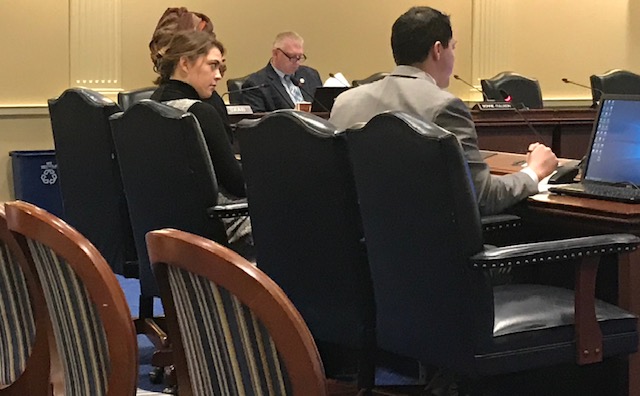@BryanRenbaum
bryan@marylandreporter.com
The Deputy Director of Government Affairs at the Maryland Department of Health told a panel of state lawmakers on Tuesday that changes to legislation designed to make membership on a committee charged with examining disparities in maternal deaths more inclusive might make the recruitment process more difficult.
The Maternal Mortality Stakeholder Review Group has 12 members. It is composed of an Asian man, an Asian woman, an African American man, four African American women and five white women. The legislation requires that composition of the group reflect the racial and ethnic diversity of Maryland women who are most impacted by maternal deaths. The amendment would mandate that membership of the committee include women who have nearly died giving birth and family members of women who have died or nearly died giving birth. The amendment also would require that, along with such women and family members, the majority of members consists of people from community organizations that specialize in maternal health.
“We did not comment on the original version of the bill because we support the intent of this bill — which is to make sure that the stakeholder group is as inclusive and as representative as possible. Our concern is really with the amendments as currently written. We feel if it moves forward as currently written it will make it difficult for us to fill the stakeholder group,” Jake Whitaker told the House Public Health and Minority Health Disparities subcommittee.
Whitaker referenced a provision related to the collection of morbidity data.
“When I consulted with our public health team they mentioned to me that the maternal stakeholder group currently does not track this data. So we would just like to work with the committee to kind of raise some of these concerns. We want to make sure that we include the folks that we are supposed to in this group but that we don’t make it difficult to convene this group.”
Chairwoman Del. Joseline Pena-Melnyk, D-Anne Arundel-Prince George’s, asked Whitaker what he would like the committee to do.
“Our suggestion would be to review these amendments and consider the original format of the bill — which is to make sure the stakeholder group is as representative as possible for these folks.
“But the department has gone through some pretty extensive recruitment processes including reaching out to all the members of the stakeholder committee. And, just frankly, we have accepted almost everybody who has applied…It’s not that we’re not making the effort to include these folks, it’s just, frankly, we’re having a little difficulty finding folks to include in the stakeholder group.”
Pena-Melnyk said the committee would agree to hold the bill for a week so that the department could work with the sponsor on the language in contention.
Del. Heather Bagnall, D-Anne Arundel, asked Whitaker if members of the stakeholder group would have to self-identify as family members of women who have experienced near-maternal death.
“The issue is not necessarily that they have to self-identify. The issue is that the maternal mortality committee doesn’t track that data related to morbidity. It specifically tracks maternal deaths. So, the committee itself just does not have the data to specifically recruit those members.”
Del. Robyn Lewis, D-Baltimore City, who said she has done recruitment work in the past, rejected Whitaker’s assertion.
“I am reminded of a theme that I hear often in talent management and recruitment. Its that: ‘We just can’t find X-type of person to fill this role…’ I’m a little concerned that somehow for an issue of this urgency — I’m hearing that refrain. And I would like to know what methods have been used to identify what the Health Department has used to recruit and identify appropriate members for the commission.”
Whitaker said the health department and the committee are working together to make sure the recruitment process is fair.
“Currently the department and the Maternal Morality Committee have reached out to the committee members who have deep roots in community organizations that have worked with these folks on the ground. They’re usually the individuals who provide us the information of the recommendations for folks to join the stakeholder group.”
Whitaker said individuals who are interested in joining the stakeholder group can apply on the department’s website.
The General Assembly established the Maternal Mortality Review Stakeholder Group in 2018. The group, according to its website, is tasked with “examining issues resulting in disparities in maternal deaths, reviewing the status of implementation of previous recommendations, and identifying new recommendations with a focus on initiatives to address disparities in maternal deaths.”
The Tuesday subcommittee meeting was its first this year. The law mandates that the committee meet at least twice a year.
The Maryland Maternal Mortality Review 2018 Annual Report.notes that the World Health Organization defines maternal death as “the death of a woman while pregnant or within 42 days of termination of pregnancy, irrespective of the duration and site of the pregnancy, from any cause related to or aggravated by pregnancy or its management but not from accidental or incidental causes.”
“The maternal mortality ratio or rate (MMR) is the number of maternal deaths per 100,000 live births in the same time period,” according to the report.
From 2011 to 2015 Maryland’s MMR dropped slightly compared to the national rate for the first time after being higher than the national average since the 1980s. The most recent data in the 2018 annual report showed that the Maryland MMR was 19% lower than the national rate.
Black women in the United States have an MMR that is 2.4 times higher than that of white women — “a disparity that has persisted since the 1940s,” the report said. The disparity is even more pronounced in Maryland: The MMR for black women in the state from 2012 to 2016 was 3.7 times the MMR of white women, according to the report.






Recent Comments